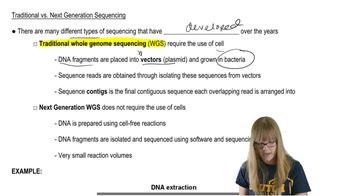Why are genes for rRNA and tRNA considered to be genes even though they do not produce polypeptides?
Table of contents
- 1. Introduction to Genetics51m
- 2. Mendel's Laws of Inheritance3h 37m
- 3. Extensions to Mendelian Inheritance2h 41m
- 4. Genetic Mapping and Linkage2h 28m
- 5. Genetics of Bacteria and Viruses1h 21m
- 6. Chromosomal Variation1h 48m
- 7. DNA and Chromosome Structure56m
- 8. DNA Replication1h 10m
- 9. Mitosis and Meiosis1h 34m
- 10. Transcription1h 0m
- 11. Translation58m
- 12. Gene Regulation in Prokaryotes1h 19m
- 13. Gene Regulation in Eukaryotes44m
- 14. Genetic Control of Development44m
- 15. Genomes and Genomics1h 50m
- 16. Transposable Elements47m
- 17. Mutation, Repair, and Recombination1h 6m
- 18. Molecular Genetic Tools19m
- 19. Cancer Genetics29m
- 20. Quantitative Genetics1h 26m
- 21. Population Genetics50m
- 22. Evolutionary Genetics29m
10. Transcription
Overview of Transcription
Problem 10
Textbook Question
Why doesn't polynucleotide phosphorylase (Ochoa's enzyme) synthesize RNA in vivo?
 Verified step by step guidance
Verified step by step guidance1
Understand the role of polynucleotide phosphorylase (PNPase): Polynucleotide phosphorylase is an enzyme that catalyzes the synthesis of RNA in vitro by adding ribonucleotides to a growing RNA chain using nucleotide diphosphates as substrates.
Recognize the difference between in vitro and in vivo conditions: In vitro refers to controlled laboratory conditions outside a living organism, while in vivo refers to processes occurring within a living organism.
Identify the substrate limitation in vivo: In vivo, the nucleotide diphosphates (NDPs) required by polynucleotide phosphorylase are not naturally abundant or available in sufficient concentrations to support RNA synthesis.
Understand the role of RNA polymerase in vivo: In living cells, RNA synthesis is carried out by RNA polymerase, which uses DNA as a template and ribonucleoside triphosphates (NTPs) as substrates, a process that is template-directed and highly regulated.
Conclude why PNPase does not synthesize RNA in vivo: Polynucleotide phosphorylase lacks the ability to use DNA as a template and is not adapted to the cellular environment, where RNA synthesis is tightly regulated by RNA polymerase and other cellular machinery.
 Verified video answer for a similar problem:
Verified video answer for a similar problem:This video solution was recommended by our tutors as helpful for the problem above
Video duration:
2mPlay a video:
Was this helpful?
Key Concepts
Here are the essential concepts you must grasp in order to answer the question correctly.
Polynucleotide Phosphorylase
Polynucleotide phosphorylase is an enzyme that catalyzes the synthesis of RNA by adding nucleotides to a growing RNA chain. It operates by using nucleoside diphosphates as substrates, facilitating the polymerization of ribonucleotides. However, it lacks the ability to initiate RNA synthesis de novo, which limits its functionality in living cells.
Recommended video:
Guided course

Post Translational Modifications
In Vivo vs. In Vitro
In vivo refers to processes or reactions occurring within a living organism, while in vitro describes those happening outside of a biological context, typically in a controlled laboratory environment. The conditions in vivo are complex, involving numerous regulatory mechanisms and cellular components that are not present in vitro, which can affect enzyme activity and RNA synthesis.
Recommended video:
Guided course

Traditional vs. Next-Gen
RNA Synthesis Regulation
RNA synthesis in living organisms is tightly regulated by various factors, including transcription factors, RNA polymerases, and the availability of substrates. In vivo, the synthesis of RNA is primarily carried out by RNA polymerases, which are more efficient and capable of recognizing specific promoter sequences, unlike polynucleotide phosphorylase, which lacks such regulatory mechanisms.
Recommended video:

 6:32m
6:32mWatch next
Master Overview of Transcription with a bite sized video explanation from Kylia
Start learningRelated Videos
Related Practice
Textbook Question
553
views

